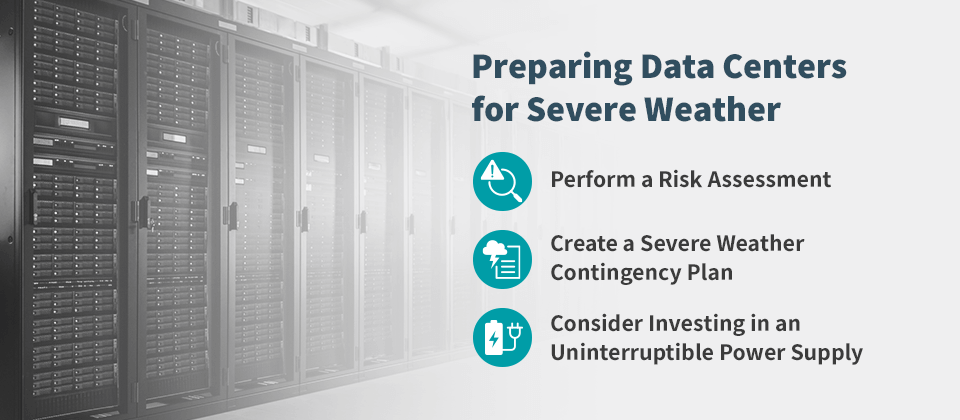
Preparing Data Centers for Severe Weather
Data centers are at the mercy of severe weather risk and must have contingency plans to prevent downtime. Even the most thoroughly protected data centers are at risk of failure when severe weather occurs. Events like lightning storms and heat waves threaten to damage data center electrical equipment, while floods can take down your operation for weeks. By following these steps, you can ensure your data center facility is prepared and minimize future downtime.
What Weather Events Should Data Centers Prepare For?
Before creating a severe weather contingency plan, it’s important to understand the risks in your specific geographical area. That way, you can plan and prepare accordingly. While conditions can vary between different regions and states, some of the biggest weather threats to data centers include:
1. Thunderstorms
Harsh winds, lightning and heavy downpours can damage power lines and lead to electrical surges, which can compromise data stored in servers. In severe cases, thunderstorms can impact entire storage systems, making them inoperable. As such, data centers should have robust surge protection systems in place.
2. Snow and Ice Storms
Data centers may generate substantial heat, but cold-weather events can still pose risks. Besides affecting battery performance, cooling systems and other essential equipment, they can cause frozen pipes and water damage.
Severe ice storms and heavy snowfall can damage physical infrastructure, and icy roadways can prevent staff from traveling to and accessing the facility. Additionally, freezing conditions can lead to network failures, communication difficulties and power outages, disrupting data access and storage.
3. Flooding and Fires
Extreme rainfall often leads to flash floods, which can physically damage data centers, servers and hardware, resulting in lost data. Likewise, low humidity and dry, hot conditions can lead to wildfires. Fire damage, smoke and ash can contaminate equipment. Both weather events can lead to prolonged downtime, potential data loss and expensive repairs.
4. Tornadoes and Hurricanes
The high winds generated by these storms can be catastrophic for data centers and infrastructure. They can cause widespread damage and power outages, disrupting data processing and storage. Data centers should be built to withstand high winds and flying debris.
How Are Data Centers Affected by Weather?
The consequences of severe weather can be numerous for data centers. Just a few of the potential effects include:
- Power and internet outages: Severe weather incidents can knock out power grids and disrupt internet services. As such, data centers can experience connectivity issues and lose access to cloud-based storage. Prolonged outages can corrupt data and lead to data synchronization issues. If the data center’s cooling system is down, it can lead to overheating and high humidity levels that can damage equipment. While generators are a common alternative power source, having access to multiple power grids can lower the risk of prolonged outages.
- Infrastructure and equipment damage: Extreme weather events can cause significant structural damage to buildings that house critical IT infrastructure. This can lead to prolonged power outages and data loss. Moreover, wind and storms cause excess dust and debris in the air, which can contaminate equipment and cooling systems.
- Fallen trees: Storms and high winds can cause trees to fall over. This can damage power lines, interrupt critical networks and cause power outages, interfering with data access and increasing the risk of corruption.
- Communication disruptions: Severe weather can affect telecommunications and internet connectivity, complicating data center operations and remote management.
Preparing Data Centers for Severe Weather
Follow these steps to better equip your data center for weather-related incidents and give your entire team more peace of mind:
1. Perform a Risk Assessment
The first step to creating a severe weather contingency plan is to analyze your facility’s risk potential. Start by comprehensively surveying your company’s physical location and analyzing how severe winds, rain or other weather may threaten the integrity of your infrastructure. For example, ask yourself if the trees and other landscaping in the surrounding area pose a threat in high winds. Determine if your facility is in a location with appropriate drainage in case of severe rain and flooding.
Severe weather may threaten the following critical utilities and infrastructure:
- Internet connectivity
- Cooling systems
- Water, natural gas and power
- Telephones and radio systems
- Roads, bridges, overpasses and local streets
If your facility already has a protection plan in place, examine its efficacy. Has it been updated within the past few years? Are there new areas for improvement? Does it account for the most recent technology your facility has implemented? Be sure your current plan is up to date.
2. Create a Severe Weather Contingency Plan
To start your contingency plan, create a checklist of precautions necessary to protect your facility from several types of severe weather emergencies. Update your checklist regularly to account for your facility’s newest technology and setup, including your cooling system’s power requirements. The checklist should also account for the staff who must be available to monitor and maintain your data center in an emergency. Depending on the proximity of your essential staff to your facility, they may require emergency housing accommodations.
In an emergency, you must be prepared to cancel your data center’s scheduled maintenance and updates so your team can focus on keeping your infrastructure online and preventing downtime. Your facility must test and adjust your contingency plan regularly to create an effective preventive plan. Test your backup power systems regularly, and test generators at least every 30 days, keeping them fueled at all times. By tracking tracking your generators energy usage, you can budget to stock up on backup fuel properly.
When severe storms strike, check your rooftop equipment and secure any potentially loose items around your data center facility. Comprehensive preparation is the best way to protect your facility from severe weather and prevent downtime.
3. Consider Investing in an Uninterruptible Power Supply
When it comes to preventing downtime, an uninterruptible power supply (UPS) can keep your data center going, regardless of the weather’s severity. A UPS can automatically provide power when your regular power supply is interrupted or fluctuates outside of safe levels. It then continues to provide you with surge-protected power for as long as you need.
Power redundancy in data centers mitigates risks and can help prepare for unexpected outages, like those caused by severe weather. As part of your center’s power redundancy plan, UPS systems help maintain your business’s wireless networking equipment, cooling solutions, security systems and computers.

Data Center Solutions From DataSpan
At DataSpan, we specialize in installing and maintaining flexible data center solutions. We build efficient and innovative data solutions specifically tailored to your operation, from critical data storage to cloud computing. Prevent interruptions to your network with the help of our experienced professionals when you find a local representative today.

About the Author: Alex von Hassler’s long term focus is the continued testing, learning, and deployment of modern IT solutions. During his years as a DataSpan team member, his responsibilities grew from managing Salesforce CRM to improving system security, creating marketing initiatives, as well as providing continued support to the highly motivated and experienced team in an ever-changing industry. As DataSpan evolves to provide the best-fitting IT solutions to its customers, Alex von Hassler continues to hone his skills in the world of web-based ERP systems, security, and best customer engagement practices. Empowering such a dynamic team with the right tools provides him with enormous gratification.








